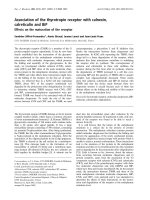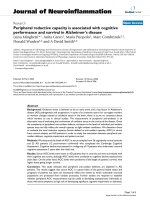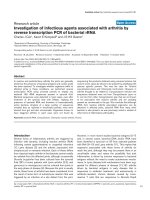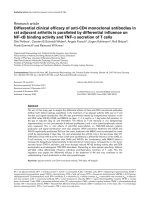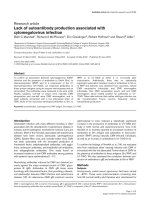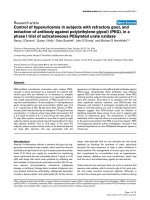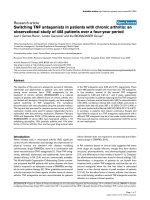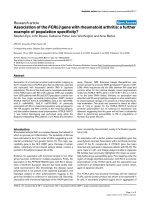Báo cáo y học: "Adalimumab clinical efficacy is associated with rheumatoid factor and anti-cyclic citrullinated peptide antibody titer reduction: a one-year prospective study" potx
Bạn đang xem bản rút gọn của tài liệu. Xem và tải ngay bản đầy đủ của tài liệu tại đây (177.46 KB, 8 trang )
Open Access
Available online />Page 1 of 8
(page number not for citation purposes)
Vol 8 No 1
Research article
Adalimumab clinical efficacy is associated with rheumatoid factor
and anti-cyclic citrullinated peptide antibody titer reduction: a
one-year prospective study
Fabiola Atzeni
1
, Piercarlo Sarzi-Puttini
1
, Donata Dell' Acqua
1
, Simona de Portu
2
,
Germana Cecchini
3
, Carola Cruini
3
, Mario Carrabba
1
and Pier Luigi Meroni
3
1
Rheumatology Unit, Department of Medicine, L Sacco University Hospital, 74 Via GB Grassi, 20157 Milano, Italy
2
CIRF/Center of Pharmacoeconomics, Faculty of Pharmacy, University of Naples, Federico II, Napoli, Italy
3
Allergy, Clinical Immunology and Rheumatology Unit, Department of Internal Medicine, University of Milan, IRCCS Istituto Auxologico Italiano, Milano,
Italy
Corresponding author: Piercarlo Sarzi-Puttini,
Received: 15 May 2005 Revisions requested: 1 Jun 2005 Revisions received: 29 Sep 2005 Accepted: 6 Oct 2005 Published: 9 Nov 2005
Arthritis Research & Therapy 2006, 8:R3 (doi:10.1186/ar1851)
This article is online at: />© 2005 Atzeni et al.; licensee BioMed Central Ltd.
This is an open access article distributed under the terms of the Creative Commons Attribution License ( />),
which permits unrestricted use, distribution, and reproduction in any medium, provided the original work is properly cited.
Abstract
Studies on autoantibody production in patients treated with
tumor necrosis factor-α (TNF-α) inhibitors reported
contradictory results. We investigated in a prospective study the
efficacy of a treatment with human monoclonal anti-TNF-α
antibody (adalimumab) in patients with rheumatoid arthritis (RA)
and we evaluated the relationship between treatment efficacy
and the incidence and titers of disease-associated and non-
organ-specific autoantibodies. Fifty-seven patients with RA not
responsive to methotrexate and treated with adalimumab were
enrolled. Antinuclear, anti-double-stranded(ds)DNA, anti-
extractable nuclear antigens, anti-cardiolipin (aCL), anti-β
2
glycoprotein I (anti-β
2
GPI) autoantibodies, rheumatoid factor
(RF) and anti-cyclic citrullinated peptide (anti-CCP)
autoantibodies were investigated at baseline and after 6 and 12
months of follow-up. Comparable parameters were evaluated in
a further 55 patients treated with methotrexate only. Treatment
with adalimumab induced a significant decrease in RF and anti-
CCP serum levels, and the decrease in antibody titers
correlated with the clinical response to the therapy. A significant
induction of antinuclear autoantibodies (ANA) and IgG/IgM anti-
dsDNA autoantibodies were also found in 28% and 14.6%
patients, respectively, whereas aCL and anti-β
2
GPI
autoantibodies were not detected in significant quantities. No
association between ANA, anti-dsDNA, aCL and anti-β
2
GPI
autoantibodies and clinical manifestations was found. Clinical
efficacy of adalimumab is associated with the decrease in RF
and anti-CCP serum levels that was detected after 24 weeks
and remained stable until the 48th week of treatment.
Antinuclear and anti-dsDNA autoantibodies, but not anti-
phospholipid autoantibodies, can be induced by adalimumab
but to a lower extent than in studies with other anti-TNF blocking
agents.
Introduction
Clinical trials in rheumatoid arthritis (RA) have demonstrated
that tumor necrosis factor-α (TNF-α) blocking agents are
highly beneficial for most patients refractory to classic treat-
ment with disease-modifying anti-rheumatic drugs [1-4]. How-
ever, a significant proportion of patients are still relatively
resistant to such a therapy [5]. No reliable markers predictive
for the clinical response have been identified, although a
recent report suggests that a decrease in rheumatoid factor
(RF) and anti-cyclic citrullinated peptide (anti-CCP) antibody
titers might be a useful adjunct in assessing the efficacy of
treatment [6]. A decrease in IgM-RF titers was initially
described by Charles and colleagues in a small series of
patients receiving infliximab [7], but then inconsistent findings
were reported [8-11].
aCL = anti-cardiolipin; ACR = American College of Rheumatology; ANA = antinuclear autoantibodies; aPL = anti-phospholipid autoantibodies; β
2
GPI
= β
2
glycoprotein I; CCP = cyclic citrullinated peptide; DAS 28 = Disease Activity Score; dsDNA = double-stranded DNA; ELISA = enzyme-linked
immunosorbent assay; ENA = extractable nuclear antigens; ESR = erythrocyte sedimentation rate; RA = rheumatoid arthritis; RF = rheumatoid factor;
TNF = tumor necrosis factor.
Arthritis Research & Therapy Vol 8 No 1 Atzeni et al.
Page 2 of 8
(page number not for citation purposes)
Recently, two papers showed a decrease in RF and anti-CCP
antibody titers in patients with RA treated with infliximab [6,8].
In both studies the decrease paralleled the improvement in dis-
ease activity score, but one group reported a return to baseline
titer levels by prolonging the follow-up to 54 and 78 weeks [8].
In contrast, autoantibodies against non-organ-specific autoan-
tigens have been reported during treatment with TNF-α block-
ing agents. Thus, antinuclear (ANA) and anti-double-stranded
DNA (anti-dsDNA) autoantibodies have been respectively
described in up to 86% and 57% of patients with RA treated
with the TNF-α blocking agent infliximab [3,7,12-16]. Lower
percentages were reported in patients treated with etanercept
[17]. Interestingly, these autoantibodies were only anecdotally
associated with clinical manifestations suggestive of a drug-
induced systemic lupus erythematosus [17]. As regards anti-
dsDNA autoantibodies, the occurrence of low-affinity autoan-
tibodies of the IgM or IgA isotype was thought to explain the
lack of such an association, in contrast with the widely
accepted relationship between high-affinity anti-dsDNA IgG
autoantibodies and systemic lupus erythematosus [13].
Although ANA and anti-dsDNA autoantibodies have been
reported at higher prevalence in patients treated with inflixi-
mab than in those treated with etanercept and in spite of the
lack of any flare in a patient with previous infliximab-induced
systemic lupus erythematosus when etanercept therapy was
started, the occurrence of these autoantibodies has been con-
sidered a drug class-related side effect [17,18].
Finally, anti-phospholipid autoantibodies – detectable mainly
by the anti-cardiolipin (aCL) assay – were also reported in
patients with RA receiving TNF-α blockers. In some cases
their appearance was related to concomitant infectious proc-
esses [19], but again contrasting results were reported and no
correlation with the clinical manifestations specific for the anti-
phospholipid syndrome was clearly found [8,9,16]. However,
a paper suggested that they might be predictive of a poor clin-
ical outcome [20].
Adalimumab, a fully human anti-TNF-α monoclonal antibody,
was recently approved for the treatment of both moderate and
severe RA [4,21,22]. The present 1-year study was planned to
evaluate the following in a prospective manner: first, the clini-
cal efficacy of adalimumab; second, whether the prevalence
and titers of RA-associated autoantibodies such as RF and
anti-CCP autoantibodies correlate with treatment effect; and
third, whether non-organ-specific autoantibodies are induced
by adalimumab as reported for other TNF-α blocking agents.
Materials and methods
Patient sera
Fifty-seven patients (53 women and 4 men; mean age at base-
line 56 years (range 28 to 83)) with refractory RA were
included in the study. The patients were selected in accord-
ance with the inclusion criteria of Adalimumab Research in
Active RA (ReAct), an open-label multicenter, multinational
phase IIIb study conducted primarily in Europe. In the ReAct
study, patients were assigned to receive single self-injections
of adalimumab subcutaneously at 40 mg every other week in
addition to their pre-existing but inadequate therapies [22]. All
patients fulfilled the 1987 American College of Rheumatology
(ACR) classification criteria for RA [23] and were treated with
methotrexate (mean dosage 10 mg per week (range 7.5 to
20)) and adalimumab (40 mg every other week as a single
dose by subcutaneous injection). In addition 55 patients with
RA treated with methotrexate only were followed up and eval-
uated with comparable parameters at 6-month intervals.
Written informed consent was obtained from all patients and
the study was approved by the Research and Ethics Commit-
tee of the L Sacco University Hospital in Milan.
Demographic and clinical data are presented in Table 1. Dur-
ing the study, 42 patients of the adalimumab group received
concomitant corticosteroids (7.5 mg per day), 48 received
non-steroidal anti-inflammatory drugs and/or analgesics, and 6
received other drugs. Patients were followed clinically at reg-
ular intervals by the same physician during this period and in
particular when they were receiving adalimumab. Clinical
assessment included the number of tender and swollen joints,
the duration of morning stiffness, erythrocyte sedimentation
rate (ESR), and C-reactive protein (CRP) (Table 2). Clinical
features suggestive of infections or autoimmune disorders
were also recorded. ESR and CRP and significant concomi-
tant clinical features suggestive of infections or autoimmune
disorders were recorded accurately (Table 2). The DAS 28 cri-
teria [24,25] were applied to assess clinical efficacy. Eighteen
patients discontinued adalimumab treatment before the end of
the study, between 3 and 12 months, because of adverse
events, treatment inefficacy or severe infectious disease.
Table 1
Clinical and demographic characteristics of the patients
Characteristic Patients with RA RA control group
Number of patients 57 55
Mean age, years (range) 56 (28–83) 63 (30–83)
Sex (F/M) 53/4 45/10
Disease duration, years (range) 8 (1–27) 6 (1–25)
Adalimumab treatment, n 57 0
Concomitant medications:
NSAID 48 34
Corticosteroids 42 30
Methotrexate 57 55
Other 6 0
NSAID, non-steroidal anti-inflammatory drugs; RA, rheumatoid
arthritis.
Available online />Page 3 of 8
(page number not for citation purposes)
Blood was drawn between 08:00 and 09:00 in the morning
when the patients visited the outpatient clinic on day 0
(screening evaluation), and after 6 and 12 months of treat-
ment. The blood was immediately centrifuged and the serum
was stored at -80°C.
Detection of RF and anti-CCP autoantibodies
Tests for IgM RF and anti-CCP autoantibodies were per-
formed at baseline and after 6 and 12 months of adalimumab
treatment. IgM RF was measured by immunonephelometry
with the quantitative N Latex RF system (Dade Behring, Mar-
burg, Germany). RF titers higher than 15 IU/ml were consid-
ered positive. Anti-CCP autoantibodies were tested by using
a second-generation commercially available ELISA kit
(Menarini Diagnostics, Florence, Italy) as described [26]. In
brief, 100 µl of anti-CCP standards (0, 2, 8, 30 and 100 U/ml),
and samples from controls and patients (diluted 1:100 in
PBS) were distributed into individual wells. The microtiter
plates were coated with highly purified synthetic cyclic pep-
tides containing modified arginine residues. After incubation
for 60 minutes, the wells were washed three times with 200 µl
wash buffer (borate buffer containing 0.8% sodium azide).
The microplates were then incubated for 30 minutes at room
temperature (22–24°C) with alkaline-phosphate-labelled
murine monoclonal antibody against human IgG and washed
again three times. A chromogenic substrate solution (Mg
2+
phenolphthalein monophosphate buffered solution) was
added to each well. After 30 minutes the reaction was
stopped with sodium hydroxide-EDTA-carbonate buffer. The
absorbance was read at 550 nm. Serum samples were evalu-
ated in triplicate, and the upper normal limit (15 arbitrary units
(AU)/ml) was assumed in accordance with the manufacturer's
recommendations. To follow the changes in antibody levels
during therapy, all serum samples displaying a high concentra-
tion (more than 100 AU/ml) were evaluated after a further 1:10
dilution and then corrected for this additional dilution factor. To
avoid any plate-to-plate variation of anti-CCP measurements,
plates from the same batch (batch number 470094) were
used; the inter-assay and intra-assay variabilities were less
than 9%.
Detection of ANA
Anti-nuclear autoantibodies were performed at baseline and
after 6 and 12 months of adalimumab treatment, by indirect
immunofluorescence with HEp2 cells as described [27]. Titers
of more than 1:160 were considered positive. Sera positive for
ANA by indirect immunofluorescence were further analysed
for the presence of anti-extractable nuclear antigens (anti-
ENA) by Addressable Laser Bead Immunoassays (Menarini
Diagnostics) in accordance with the manufacturer's instruc-
tions [28].
Tests for anti-dsDNA IgG autoantibodies were performed at
baseline and after 6 and 12 months of treatment with adalimu-
mab by using enzyme-immunoassay (EIA) (Pharmacia Diag-
nostics, Friburg, Germany); positive samples were also
evaluated by Farr assay and by indirect immunofluorescence
with Crithidia luciliae (CLIFT) as described [29]. Anti-dsDNA
autoantibodies of the IgM isotype have been also detected by
CLIFT with a specific anti-human µ chain antiserum (MP Bio-
medicals, Aurora, OH, USA).
Detection of anti-phospholipid autoantibodies
Anti-phospholipid autoantibodies (aPL) were detected as aCL
and as anti-β
2
glycoprotein I (anti-β
2
GPI) by ELISA as
described [30]; values were expressed as IgG or IgM aPL
units (GPL or MPL, respectively; considered positive when
more than 10 GPL or MPL units) for aCL and as OD values for
anti-β
2
GPI autoantibodies (results higher than the 95th per-
centile of 50 normal healthy controls were considered posi-
tive: more than 0.130 for IgG and more than 0.280 for IgM)
[30]. Anti-cardiolipin and anti-β
2
GPI autoantibodies were
evaluated at baseline and after 6 and 12 months of adalimu-
mab treatment. The sera of the control group of patients with
RA were analyzed twice with a 1-year interval.
Table 2
Clinical characteristics of patients at baseline and after 24 and 48 weeks of adalimumab treatment
Variable Week 0 Week 24 P Week 48 P
DAS 28 5.4 ± 1.3 3.6 ± 1.2 <0.01 2.7 ± 0.9 <0.01
Tender joint count 12.4 ± 4.7 5.1 ± 3.5 <0.01 4.9 ± 3.5 <0.01
Swollen joint count 10.4 ± 3.8 3.2 ± 3.4 <0.01 3.12 ± 3.4 <0.01
ESR (mm/h) 35 ± 17 26 ± 16 <0.01 24 ± 15 <0.01
CRP (mg/dl) 42 ± 22.7 21 ± 15.2 <0.01 15 ± 14.8 <0.01
Anti-CCP (AU)
a
116.9 ± 43.6 100.5 ± 46.5 <0.01 78.5 ± 43.9 <0.01
RF (IU) 121.7 ± 120.6 81 ± 90 <0.01 70.2 ± 82.7 <0.01
a
Only anti-CCP positive patients at baseline (46 of 57) were included in the evaluation. Results are mean values ± SD. AU, arbitrary units; CCP,
cyclic citrullinated peptide; CRP, C-reactive protein; DAS 28 = Disease Activity Score; ESR, erythrocyte sedimentation rate; RF, rheumatoid
factor.
Arthritis Research & Therapy Vol 8 No 1 Atzeni et al.
Page 4 of 8
(page number not for citation purposes)
Statistics
Statistical analysis (95% and 99% confidence intervals) was
performed with the χ
2
test when applicable and with Fisher's
exact test in other conditions (when the expected value under
null hypothesis was less than 5). Wilcoxon's test was applied
in comparisons of continuous variables. Correlations were
expressed with Spearman's rank correlation coefficient. Prob-
ability (p) values less than 0.05 were considered statistically
significant. Data were analyzed with SPSS statistical software
10.00 for Windows (SPSS, Inc, Chicago, IL, USA). Statistical
analysis was calculated by Last Observation Carried Forward
(LOCF).
Results
Response to therapy
An ACR 20 response was achieved by 88% of patients at 24
weeks, and by 80% at 48 weeks. ACR 50 (ACR 70) percent-
ages were 51 (54) and 14 (26) at 24 and 48 weeks,
respectively.
Table 2 reports the decrease in DAS 28 values, the tender and
swollen joint counts and the ESR and CRP values during the
study. The group of patients treated with methotrexate alone
displayed a stable disease activity during the study with no sig-
nificant changes in all the clinical assessment parameters
(data not shown).
Modification of anti-CCP antibody and RF titers during
adalimumab treatment
At baseline, 46 of the 57 patients with RA (80.7%) were pos-
itive for anti-CCP autoantibodies, and 43 of 57 (75%) were
positive for RF. A strong correlation between anti-CCP and RF
at baseline was observed (χ
2
, p < 0.001). Although no
patients who were positive for anti-CCP or RF at baseline
became negative after anti-TNF-α treatment, both RF serum
titers and anti-CCP autoantibodies decreased significantly at
week 24 (p < 0.01 and p < 0.01, respectively) and week 48
(p < 0.01 and p < 0.01, respectively) (Table 2). When we
grouped the patients on the basis of their clinical response
(ACR improvement criteria) to adalimumab, a significant
decrease in RF serum titers was observed in those who were
clinically improved according to ACR 20 and ACR 50 at
weeks 24 and 48, whereas a decrease was also found for
ACR 70 at week 48 (Table 3). Anti-CCP antibody titers
declined in patients who were clinically improved according to
ACR 50 at week 24 and in those who were improved accord-
ing to ACR 20, ACR 50 and ACR 70 at week 48 (Table 4).
The Spearman's correlation coefficient of the improvement in
the DAS 28 values with the decrease in RF titer at week 48
was 0.316 (p = 0.018), and that for the anti-CCP autoantibod-
ies titer was 0.33 (p = 0.013). No significant change in RF and
anti-CCP titers was observed in patients treated with meth-
otrexate alone (data not shown).
Occurrence of ANA in patients treated with adalimumab
At baseline, 4 of 57 (7%) adalimumab-treated patients with
RA, and 5 of 55 (9%) methotrexate-treated patients with RA
tested positive for ANA (Table 5). After 12 months of therapy,
induction of ANA was observed in 16 of 57 (28%) adalimu-
mab-treated patients with RA, and in 8 of 55 (14.5%) with
methotrexate only (Table 5). The difference in ANA positivity
before and after the end of follow-up was statistically signifi-
Table 3
Decrease of RF titers in adalimumab treated patients: correlation with the clinical response to treatment
ACR response, week 24 Week 0 Week 24 P ACR response, week 48 Week 0 Week 48 P
<20% (n = 6) 130.5 ± 97.9 116.5 ± 88.6 n.s. <20% (n = 3) 89 ± 73 60.3 ± 49.2 n.d.
ACR 20 (n = 22) 155.3 ± 147.5 109 ± 123 <0.0001 ACR 20 (n = 23) 164.5 ± 141.3 105.7 ± 112.6 <0.0001
ACR 50 (n = 21) 94.1 ± 60.9 57.3 ± 36.2 <0.0001 ACR 50 (n = 16) 96.4 ± 73.2 51.6 ± 41 0.0001
ACR 70 (n = 8) 94.8 ± 164.2 40.4 ± 54 n.s. ACR 70 (n = 15) 89.5 ± 123.4 37.5 ± 40.7 0.018
Results are means ± SD. ACR, American College of Rheumatology; n.d., not done; n.s., not significant; RF, rheumatoid factor.
Table 4
Anti-CCP titer decrease in adalimumab treated patients: correlation with the clinical response to treatment
ACR response, week 24 Week 0 Week 24 P ACR response, week 48 Week 0 Week 48 P
<20% (n = 6) 118.4 ± 34.9 111.8 ± 48.8 n.s. <20% (n = 3) 107 ± 14.1 68.4 ± 23.3 n.d.
ACR 20 (n = 21) 111.5 ± 45.9 104.3 ± 48.5 n.s. ACR 20 (n = 21) 121.8 ± 48.2 88.6 ± 52.6 0.001
ACR 50 (n = 16) 121.9 ± 45.1 93.9 ± 46.4 0.001 ACR 50 (n = 13) 119.6 ± 45.8 73.5 ± 36.2 0.001
ACR 70 (n = 3) 126.8 ± 51.9 85.9 ± 43.5 n.d. ACR 70 (n = 9) 105.3 ± 37.7 65.3 ± 35.5 0.003
46 anti-CCP-positive patients at baseline were included in the evaluation. Results are means ± SD. CCP, cyclic citrullinated peptide; n.d., not
done; n.s., not significant.
Available online />Page 5 of 8
(page number not for citation purposes)
cant for the adalimumab-treated group only (p < 0.01). All the
induced ANAs were still positive at the end of the study,
including 6 of 18 patients who discontinued the treatment.
No patient was positive for IgG or IgM anti-dsDNA autoanti-
bodies in either the adalimumab-treated group or the meth-
otrexate-treated group at baseline. By solid-phase ELISA, the
presence of IgG anti-dsDNA autoantibodies was observed in
2 of 57 (3.5%) adalimumab-treated patients with RA after 6
months of treatment and in 4 of 57 (7%) after 12 months of
treatment (Table 5). All the positive samples displayed low
antibody titers (less than 25 AU/ml, normal value 17 AU/ml,
mean values +5 SD for 100 normal blood donors, matched for
age and sex). The positive samples displayed low titers (less
than 1/80) in the CLIFT assay and were negative in the Farr
assay (data not shown). Immunoglobulin G anti-dsDNA
autoantibodies were associated with positivity for ANA, and
remained positive until the end of the study, including three of
four positive patients who discontinued the treatment.
Five of 57 (5.1%) and 7 of 57 (14.6%) patients receiving adal-
imumab were positive for IgM anti-dsDNA autoantibodies after
24 and 48 weeks of treatment, respectively. The occurrence
of IgM anti-dsDNA autoantibodies was associated with the
presence of IgG anti-dsDNA only in two patients at the 24th
week and in four patients at the 48th week after treatment.
None of the patients with RA treated only with methotrexate
displayed IgG or IgM anti-dsDNA autoantibodies during fol-
low-up. As regards anti-ENA autoantibodies, three patients
were positive for anti-Ro (52 and 60 kDa) before adalimumab
and two additional patients became positive during treatment.
Four patients were positive for anti-Ro (52 and 60 kDa)
autoantibodies before methotrexate treatment and a further
one became positive for anti-Ro at the end of follow-up (Table
5).
The presence of anti-nuclear and anti-dsDNA autoantibodies
was not associated with any clinical event.
Occurrence of anti-phospholipid autoantibodies in
patients with RA treated with adalimumab
No patients with RA were positive for aCL or for anti-β
2
GPI
autoantibodies at baseline. At the end of the study, aCL were
detected at low titers (less than 20 GPL or MPL units) in two
patients in both groups; anti-β
2
GPI autoantibodies were found
in one patient in the adalimumab-treated group at low titers
(IgG 0.201 and IgM 0.312 OD values, respectively) and in
none of the patients treated with methotrexate only. All aCL
and anti-β
2
GPI autoantibodies were detected in patients
positive for ANA. No correlation was found between aPL and
clinical status (including lupus-like symptoms or thrombosis)
or the occurrence of side effects (including infections).
Discussion
Anti-TNF-α agents, such as infliximab and etanercept, have
been reported to be beneficial for patients with RA not respon-
sive to conventional treatment [1-3,5]. Our study confirms that
adalimumab, a new fully human anti-TNF-α monoclonal anti-
body, is also effective in improving the clinical scores in
patients with RA. A decrease in RF and anti-CCP antibody tit-
ers has been recently correlated with clinical improvement
after infliximab therapy in patients with RA [6-8]. It has been
suggested that blocking TNF-α might have an inhibitory effect
on the production of autoantibodies closely related to RA dis-
ease activity [6]. Actually, besides their diagnostic value, high
RF serum levels were shown to be an independent predictor
for deteriorating radiological damage, and a greater preva-
lence of anti-CCP autoantibodies was found in patients who
develop severe radiological damage [31-36]. However,
whereas RF titer reduction was also reported by other groups
after infliximab and etanercept therapy [7,8,10,11,37-39],
contrasting results were found for anti-CCP antibody levels
[7,8,10,11,37-39]. Such a discrepancy might be related, at
least in part, to the different periods of follow-up and to the
methods used to measure the antibody levels in the different
studies. In fact, most of the enrolled patients displayed an
aggressive form of the disease with high anti-CCP antibody tit-
ers; however, not all the studies performed serial serum sam-
ple dilutions or tried to reduce the batch-to-batch variability in
performing the solid-phase assays for anti-CCP detection.
This could have made the laboratory tests too insensitive to
detect variations in the antibody titers during treatment.
Our results show a significant decrease in anti-CCP autoanti-
bodies and RF titers after both 6 and 12 months of adalimu-
mab therapy. Thus, serial evaluation of these autoantibodies
seems to be useful in monitoring the clinical course of patients
Table 5
Antinuclear antibody detection during adalimumab treatment
Treatment Week Number of positive ANA sera (%)
ANA Anti-dsDNA Anti-ENA
Adalimumab (n = 57) 0 4 (7) 0 (0) 3 (5.2)
24 9 (16) 2 (3.5) 0
48 12 (21) 4 (7) 2 (3.5)
Total 16 (28) 4 (7) 5 (9)
P <0.01 <0.05 n.s.
Control RA (n = 55) 0 5 (9) 0 4 (7)
24 2 (3.5) 0 0
48 3 (5.2) 0 1 (1.7)
Total 8 (14.5) 0 (0) 5 (8.7)
P n.s. n.s.
ANA, antinuclear antibodies; anti-dsDNA, anti-double-stranded DNA
autoantibodies; ENA, extractable nuclear antigens; n.s., not
significant; RA, rheumatoid arthritis.
Arthritis Research & Therapy Vol 8 No 1 Atzeni et al.
Page 6 of 8
(page number not for citation purposes)
with RA undergoing therapy with adalimumab, as previously
suggested for infliximab [6]. It is possible that anti-CCP-posi-
tive patients with RA might display a more active disease asso-
ciated with a higher response to therapy in comparison with
patients negative for anti-CCP autoantibodies. This finding
might explain, at least in part, the association between the clin-
ical response and the decrease in anti-CCP titer. An additional
study with a larger series of anti-CCP-negative patients with
RA would be necessary to evaluate such a hypothesis,
because the number of anti-CCP-negative patients in the
present study was too small.
In contrast, results of studies on the association between the
response to conventional RA treatment and the decrease in
RF and/or anti-CCP autoantibodies have been inconsistent. A
decrease in serum RF levels has been reported in association
with successful treatment with methotrexate and gold salts
[40]. A more recent study confirmed the association between
decrease in RF titer and treatment response; in contrast, a
shorter disease duration but not a specific treatment was
associated with a decline in anti-CCP levels [39]. We did not
find any variation in RF and anti-CCP antibody serum levels in
the group of patients with RA who were treated with meth-
otrexate alone. However, it must be pointed out that these
patients did not display the same clinical characteristics as the
patients with RA selected for the adalimumab treatment. More-
over, they were already receiving treatment with methotrexate
when included and displayed a stable clinical course of the
disease. It is therefore likely that a possible decrease in anti-
body titer could have already taken place, with no additional
effect of treatment being detectable.
The mechanisms by which TNF-α blocking agents could lead
to a decrease in titers of autoantibodies closely related to RA
is still matter of speculation. Either the downregulation of pro-
inflammatory processes and/or the modulation of apoptosis
has been suggested to have a role in autoantibody production
or in protein citrullination that eventually might trigger the B
cell responses [17,41,42]. In contrast, we confirmed the
development of ANA and anti-dsDNA autoantibodies in our
adalimumab-treated patients. Although the prevalence of IgG
anti-dsDNA was comparable to that recently reported by Key-
stone and Haraoui [43], the number of ANA positive patients
was slightly larger at the end of the treatment. However, both
autoantibodies occurred at lower frequency than those
reported in series of patients treated with infliximab or etaner-
cept [17].
As previously reported in patients treated with different anti-
TNF-α blocking agents, an increased frequency of anti-dsDNA
autoantibodies of the IgM isotypes have also been found in our
patients treated with adalimubab [7]. Clinical monitoring of the
subgroup of patients positive for ANA and anti-dsDNA autoan-
tibodies did not show any manifestation potentially related to
a full-blown lupus disease. Accordingly, IgG anti-dsDNA
autoantibodies seemed to be at low titers and to display low
affinity, as demonstrated by their negativity in the Farr assay.
We did not find aPL at baseline in our patients with RA. Anti-
cardiolipin autoantibodies were induced in 3.5% (2 of 57) and
1.8% (1 of 55) of our patients with RA, treated respectively
with adalimumab or methotrexate only, whereas only one
patient in the adalimumab group became positive for IgG and
IgM anti-β
2
GPI autoantibodies. Moreover, the titers were all
low and no clinical manifestations potentially related to the
anti-phospholipid syndrome were recorded. Previous studies
reported higher aPL frequencies both at baseline [44,45] and
after anti-TNF-α therapy [8,9,16,19]. The difference with our
results is probably related to the specificity of the assays we
used, as demonstrated in a recent multicenter study [30].
Although at lower frequency than that reported with other
TNF-α blocking agents, both ANA and aPL were clearly
associated with adalimumab treatment. It has been suggested
that a complex series of events related to TNF-α blockage
might have a role in favoring the appearance of these autoan-
tibodies. A dysregulation of apoptosis seems to be the most
likely mechanism. Apoptotic cells do in fact expose nuclear
antigens on their surface, and apoptotic blebs have been
reported to expose anionic phospholipids (mainly phosphati-
dylserine) that in turn are able to bind circulating β
2
GPI; both
phenomena might act as persistent immunogenic stimuli that
could end in an antibody response against the self molecules
[46,47]. In line with such a hypothesis is the recent demon-
stration that plasma levels of plasma nucleosomes were higher
after infliximab treatment [48]. However, dysregulation and/or
inhibition of the cytotoxic T lymphocyte response normally sup-
pressing autoreactive B cells might be involved [17,49].
Conclusion
Our results confirm the clinical efficacy of adalimumab, a new
fully human anti-TNF-α monoclonal antibody, in improving the
clinical score in patients with active RA that was not respon-
sive to the conventional treatment. Such an effect is associ-
ated with a decrease in serum levels of RF and anti-CCP
antibody levels, which was detected after 24 weeks and
remained stable until 48 weeks of treatment. Induction of ANA,
low-titer IgG/IgM anti-dsDNA but not aPL seems to be a drug-
class-related effect, because increased antibody levels were
found during treatment; however, no related clinical manifesta-
tions were recorded and antibody frequency was found to be
lower than in studies with other TNF blocking agents.
Competing interests
The authors declare that they have no competing interests.
Authors' contributions
FA and MC participated in the design of the study and in the
clinical evaluation of the patients. DDA, GC and CC per-
formed the immunoassays. PSP and PM participated in the
design and coordination of the study and helped to draft the
Available online />Page 7 of 8
(page number not for citation purposes)
manuscript. SD participated in the study and performed the
statistical analysis. All authors read and approved the final
manuscript.
References
1. Bathon JM, Martin RW, Fleischmann RM, Tesser JR, Schiff MH,
Keystone EC, Genovese C, Wasko MC, Moreland LW, Weaver
AW, et al.: A comparison of etanercept and methotrexate in
patients with early rheumatoid arthritis. N Engl J Med 2000,
343:1586-1593.
2. Elliott MJ, Maini RN, Feldmann M, Kalden JR, Antoni C, Smolen JS,
Leeb B, Breedveld FC, Macfarlane JD, Bijl H, et al.: Randomised
double-blind comparison of chimeric monoclonal antibody to
tumour necrosis factor alpha (cA2) versus placebo in rheuma-
toid arthritis. Lancet 1994, 344:1105-1110.
3. Lipsky PE, van der Heijde DM, St Clair EW, Furst DE, Breedveld
FC, Kalden JR, Smolen JS, Weisman M, Emery P, Feldmann M, et
al.: Infliximab and methotrexate in the treatment of rheumatoid
arthritis. Anti-Tumor Necrosis Factor Trial in Rheumatoid
Arthritis with Concomitant Therapy Study Group. N Engl J Med
2000, 343:1594-1602.
4. Moreland L: Adalimumab in rheumatoid arthritis. Curr Rheuma-
tol Rep 2004, 6:333-334.
5. St Clair EW: Infliximab treatment for rheumatic disease: clini-
cal and radiological efficacy. Ann Rheum Dis 2002, 61 Suppl
2:ii67-ii69.
6. Alessandri C, Bombardieri M, Papa N, Cinquini M, Magrini L, Tin-
cani A, Valesini G: Decrease of anti-cyclic citrullinated peptide
antibodies and rheumatoid factor following anti-TNFα therapy
(infliximab) in rheumatoid arthritis is associated with clinical
improvement. Ann Rheum Dis 2004, 63:1218-1221.
7. Charles PJ, Smeenk RJ, De Jong J, Feldmann M, Maini RN:
Assessment of antibodies to double-stranded DNA induced in
rheumatoid arthritis patients following treatment with inflixi-
mab, a monoclonal antibody to tumor necrosis factor-α: find-
ings in open-label and randomised placebo-controlled trials.
Arthritis Rheum 2000, 43:2383-2390.
8. Bobbio-Pallavicini F, Alpini C, Caporali R, Avalle S, Bugatti S, Mon-
tecucco C: Autoantibody profile in rheumatoid arthritis during
long-term infliximab treatment. Arthritis Res Ther 2004,
6:R264-R272.
9. Eriksson C, Engstrand S, Sundqvist KG, Rantapaa-Dahlqvist S:
Autoantibody formation in patients with rheumatoid arthritis
treated with anti-TNFα. Ann Rheum Dis 2005, 64:403-407.
10. De Rycke L, Verhelst X, Kruithof E, Van den Bosh F, Hoffman IE,
Veys EM, De Keyser F: Rheumatoid factor, but not anti-cyclic
citrullinated peptide antibodies, is modulated by infliximab
treatment in rheumatoid arthritis. Ann Rheum Dis 2005,
64:299-302.
11. Caramaschi P, Biasi D, Tonolli E, Pieropan S, Martinelli N, Carletto
A, Volpe A, Bambara LM: Antibodies against cyclic citrullinated
peptides in patients affected by rheumatoid arthritis before
and after infliximab treatment. Rheumatol Int 2005, 26:58-62.
12. Antivalle M, Marazza MG, Randisi G, Sarzi-Puttini P, Dell'Acqua D,
Carrabba M: Longterm treatment of rheumatoid arthritis with
infliximab: efficacy, side effects and autoantibodies induction
[abstract]. Arthritis Rheum 2002, 46:s534.
13. De Rycke L, Kruithof E, Van Damme N, Hoffman IE, Van den Boss-
che N, Van den Bosch F, Veys EM, De Keyser F: Antinuclear anti-
bodies following infliximab treatment in patients with
rheumatoid arthritis or spondylarthropathy. Arthritis Rheum
2003, 48:1015-1023.
14. Louis M, Rauch J, Armstrong M, Fitzcharles MA: Induction of
autoantibodies during prolonged treatment with infliximab. J
Rheumatol 2003, 30:2557-2562.
15. Allanore Y, Sellam J, Batteux F, Job Deslandre C, Weill B, Kahan
A: Induction of autoantibodies in refractory rheumatoid arthri-
tis treated by infliximab. Clin Exp Rheumatol 2004, 22:756-758.
16. Ferraro-Peyret C, Coury F, Tebib JG, Bienvenu J, Fabien N: Inflix-
imab therapy in rheumatoid arthritis and ankylosing spondyli-
tis-induced specific antinuclear and antiphospholipid
autoantibodies without autoimmune clinical manifestations: a
two-year prospective study. Arthritis Res Ther 2004,
6:R535-R543.
17. Ziolkowska M, Maslinski W: Laboratory changes on anti-tumor
necrosis factor treatment in rheumatoid arthritis. Curr Opin
Rheumatol 2003, 15:267-273.
18. Debandt M, Vittecoq O, Descamps V, Le Loet X, Meyer O: Anti-
TNFα-induced systemic lupus erythematosus. Clin Rheumatol
2003, 22:56-61.
19. Ferraccioli G, Mecchia F, Di Poi E, Fabris M: Anticardiolipin anti-
bodies in rheumatoid patients treated with etanercept or con-
ventional comnination therapy: direct and indirect evidence for
a possible association with infections. Ann Rheum Dis 2002,
61:358-361.
20. Jonsdottir T, Forslid J, van Vollenhoven A, Harju A, Brannenmark S,
Klareskog L, van Vollenhoven RF: Treatment with anti-TNFα
antagonists in patients with rheumatoid arthritis induces anti-
cardiolipin antibodies. Ann Rheum Dis 2004, 63:1075-1078.
21. Weinblatt ME, Keystone EC, Furst DE, Moreland LW, Weisman
MH, Birbara CA, Teoh LA, Fischkoff SA, Chartash EK: Adalimu-
mab, a fully human anti-tumor necrosis factor alpha mono-
clonal antibody, for the treatment of rheumatoid arthritis in
patients taking concomitant methotrexate: the ARMADA trial.
Arthritis Rheum 2003, 48:35-45.
22. Burmester GR, Monteagudo Saez I, Malaise M, Canas da Silva J,
Webber DG, Kupper H: Efficacy and safety of Adalimumab
(HUMIRA) in European Clinical Practice: The ReAct trial. Ann
Rheum Dis 2004:s63. [abstract]
23. Arnett FC, Edworthy SM, Bloch DA, McShane DJ, Fries JF, Cooper
NS, Healey LA, Kaplan SR, Liang MH, Luthra HS, et al.: The Amer-
ican Rheumatism Association 1987 revised criteria for the
classification of rheumatoid arthritis. Arthritis Rheum 1988,
31:315-324.
24. van der Heijde DM, van't Hof M, van Riel PL, van de Putte LB:
Development of a disease activity score based on judgment in
clinical practice by rheumatologists. J Rheumatol 1993,
20:579-581.
25. Felson DT, Anderson JJ, Boers M, Bombardier C, Furst D, Gold-
smith C, Katz LM, Lightfoot R Jr, Paulus H, Strand V, et al.: Amer-
ican College of Rheumatology. Preliminary definition of
improvement in rheumatoid arthritis. Arthritis Rheum 1995,
38:727-735.
26. Avcin T, Cimaz R, Falcini F, Zulian F, Martini G, Simonini G,
Porenta-Besic V, Cecchini G, Borghi MO, Meroni PL: Prevalence
and clinical significance of anti-cyclic citrullinated peptide anti-
bodies in juvenile idiopathic arthritis. Ann Rheum Dis 2002,
61:608-611.
27. Bayer PM, Bauerfeind S, Bienvenu J, Fabien N, Frei PC, Gilburd B,
Heide KG, Hoier-Madsen M, Meroni PL, Monier JC, et al.: Multi-
center evaluation study on a new HEp2 ANA screening
enzyme immune assay. J Autoimmun 1999, 13:89-93.
28. Fritzler MJ: New technologies in the detection of autoantibod-
ies evaluation of addressable laser bead immunoassays
(ALBIA). In Autoantigens, Autoantibodies, Autoimmunity Volume
4. Edited by: Conrad K, Bachmann MP, Chan EKL, Fritzler MJ,
Humbel RL, Sack U, Shoenfeld Y. Berlin: Pabst Science
Publishers; 2004:449-462.
29. Riboldi P, Gerosa M, Moroni G, Radice A, Sinico A, Tincani A,
Meroni PL: Anti-DNA antibodies: a diagnostic and prognostic
tool for systemic lupus erythematosus? Autoimmunity 2005,
38:39-45.
30. Tincani A, Allegri F, Sanmarco M, Cinquini M, Taglietti M, Balestri-
eri G, Koike T, Ichikawa K, Meroni P, Boffa MC: Anticardiolipin
antibody assay: a methodological analysis for a better consen-
sus in routine determinations – a cooperative project of the
European Antiphospholipid Forum. Thromb Haemost 2001,
86:575-583.
31. Bukhari M, Lunt M, Harrison BJ, Scott DG, Symmons DP, Silman
AJ: Rheumatoid factor is the major predictor of increasing
severity of radiographic erosions in rheumatoid arthritis:
results from the Norfolk Arthritis Register Study, a large incep-
tion cohort. Arthritis Rheum 2002, 46:906-912.
32. Schellekens GA, Visser H, de Jong BA, van den Hoogen FH,
Hazes JM, Breedveld FC, van Venrooij WJ: The diagnostic prop-
erties of rheumatoid arthritis antibodies recognizing a cyclic
citrullinated peptide. Arthritis Rheum 2000, 43:155-163.
33. Kroot EJ, de Jong BA, van Leeuwen MA, Swinkels H, van den
Hoogen FH, van't Hof M, van de Putte LB, van Rijswijk MH, van
Venrooij WJ, van Riel PL: The prognostic value of anti-cyclic cit-
Arthritis Research & Therapy Vol 8 No 1 Atzeni et al.
Page 8 of 8
(page number not for citation purposes)
rullinated peptide antibodies in patients with recent-onset
rheumatoid arthritis. Arthritis Rheum 2000, 43:1831-1835.
34. Meyer O, Labarre C, Dougados M, Goupilee P, Cantagrel A,
Dubois A, Nicaise-Roland P, Sibilia J, Combe B: Anti-citrullinated
protein/peptide antibody assay in early rheumatoid arthritis
for predicting five year radiographic damage. Ann Rheum Dis
2003, 62:120-126.
35. Bas S, Genevay S, Metyer O, Gabay C: Anti-cyclic citrullinated
peptide antibodies, IgM and IgA rheumatoid factors in the
diagnosis and prognosis of rheumatoid arthritis. Rheumatol-
ogy (Oxford) 2003, 42:677-680.
36. van Venrooij WJ, Hazes JM, Visser H: Anticitrullinated protein/
peptide antibody and its role in the diagnosis and prognosis of
early rheumatoid arthritis. Neth J Med 2002, 60:383-388.
37. Chen HA, Lin KC, Chen CH, Liao HT, Wang HP, Chang HN, Tsai
CY, Chou CT: The effect of etanercept on anti-cyclic citrulli-
nated peptide antibodies and rheumatoid factor in patients
with rheumatoid arthritis. Ann Rheum Dis in press.
38. Yazdani-Biuki B, Standlmainer E, Mulabecirovic A, Brezinschek R,
Tilz G, Demel U, Mueller T, Brickmann K, Graninger WB, Brezin-
schek HP: Blockade of tumor necrosis factor α significantly
alters the serum levels of IgG- and IgA-rheumatoid factor in
patients with rheumatoid arthritis. Ann Rheum Dis 2005,
64:1224-1226.
39. Mikuls TR, O'Dell JR, Stoner JA, Parrish LA, Arend WP, Norris JM,
Holers VM: Association of rheumatoid arthritis treatment
response and disease duration with declines in serum levels
of IgM rheumatoid factor and anti-cyclic citrullinated peptide
antibody. Arthritis Rheum 2004, 50:3776-3782.
40. Furst DE: Rational use of disease-modifying antirheumatic
drugs. Drugs 1990, 39:19-37.
41. Inagaki M, Takahara H, Nishi Y, Sugawara K, Sato C: Ca
2+
-
dependent deimination induced disassembly of intermediate
filaments involves specific modification of the amino-terminal
head domain. J Biol Chem 1989, 264:18119-18127.
42. Lugering A, Schmidt M, Lugering N, Pauels HG, Domaschke W,
Kucharzik T: Infliximab induces apoptosis in monocytes from
patients with chronic active Crohn's disease by using a cas-
pase-dependent pathway. Gastroenterology 2001,
121:1145-1157.
43. Keystone E, Haraoui B: Adalimumab therapy in rheumatoid
arthritis. Rheum Dis Clin North Am 2004, 30:349-364.
44. Keane A, Woods R, Dowding V, Roden D, Barry C: Anticardiolipin
antibodies in rheumatoid arthritis. Br J Rheumatol 1987,
26:346-350.
45. Wolf P, Gretler J, Aglas F, Auer-Grumbach P, Rainer F: Anticardi-
olipin antibodies in rheumatoid arthritis: their relation to rheu-
matoid nodules and cutaneous vascular manifestations. Br J
Dermatol 1994, 131:48-51.
46. Casciola-Rosen L, Rosen A, Petri M, Schlissel M: Surface blebs
on apoptotic cells are sites of enhanced procoagulant activity:
implications for coagulation events and antigenic spread in
systemic lupus erythematosus. Proc Natl Acad Sci USA 1996,
93:1624-1629.
47. Price BE, Rauch J, Shia MA, Walsh MT, Lieberthal W, Gilligan HM,
O'Laughlin T, Koh JS, Levine JS: Anti-phospholipid autoantibod-
ies bind to apoptotic, but not viable, thymocytes in a beta 2-
glycoprotein I-dependent manner. J Immunol 1996,
157:2201-2208.
48. D'Auria F, Rovere-Querini P, Giazzon M, Ajello P, Baldissera E,
Manfredi AA, Sabbadini MG: Accumulation of plasma nucleo-
somes upon treatment with anti-tumour necrosis factor-alpha
antibodies. J Intern Med 2004, 255:409-418.
49. Via CS, Shustov A, Rus V, Lang T, Nguyen P, Finkelman FD: In vivo
neutralization of TNF-alpha promotes humoral autoimmunity
by preventing the induction of CTL. J Immunol 2001,
167:6821-6826.
